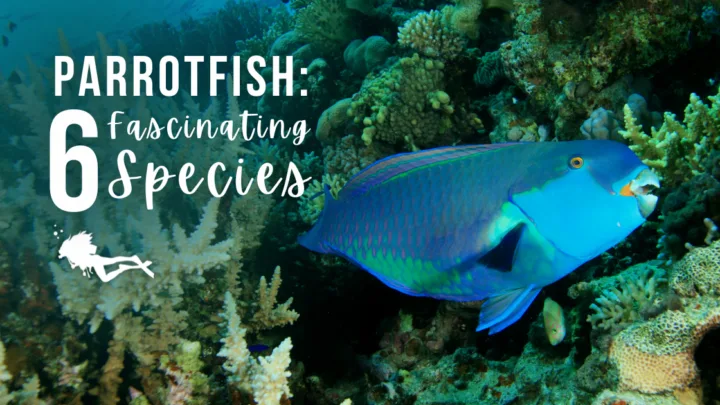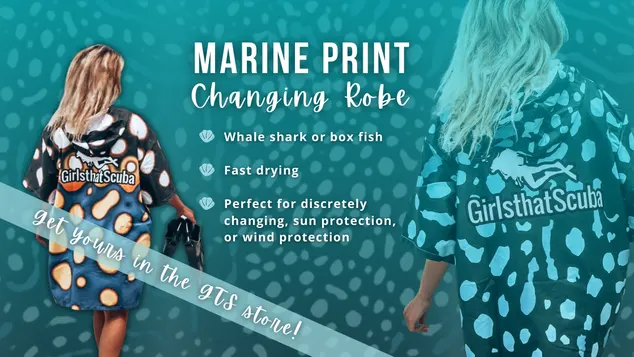Parrotfish vary drastically from species to species, and there are roughly 90 species of parrotfish in the Scaridae family. Plus, they tend to change colour as they mature and change gender (more on that later), which makes identifying them a little bit tricky.
Here, we’ll explore some of the most famous parrotfish species, as well as sharing the best spots to dive or swim with parrotfish.
Parrotfish: The Basics
World-class dive destinations like Hawaii and the Maldives are famed for their pristine coral reefs and white sandy beaches… but did you know that a lot of this sand is actually parrotfish poop?
Parrotfish break off chunks of coral and grind it down to extract the nutrient-rich parts, such as algae and soft tissue. The ‘bad,’ non-digestible stuff (like calcium carbonate) comes out the other end as fine sand.
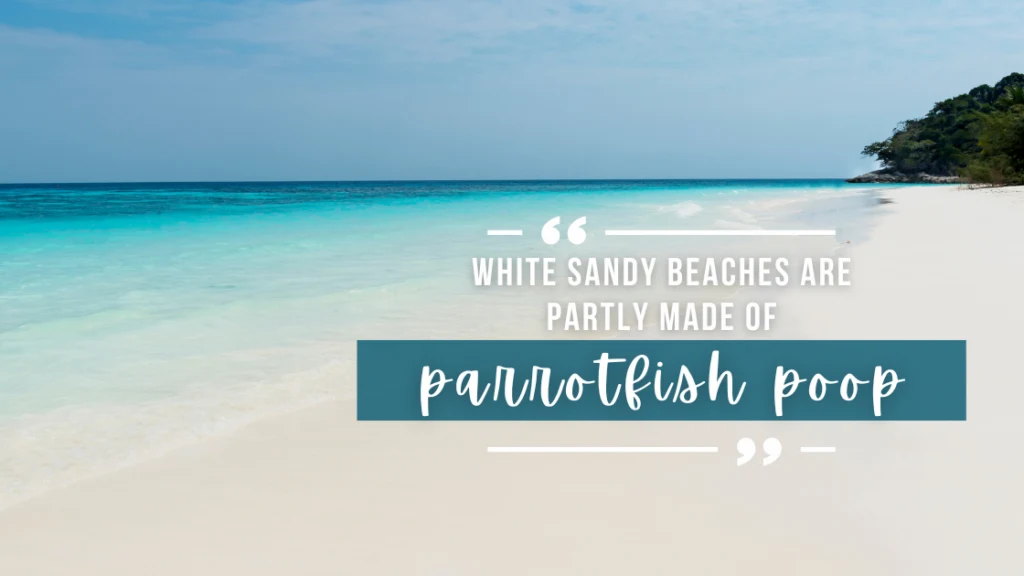
Parrotfish teeth need to be incredibly sharp to grind down their favourite snack, and they have hundreds of them fused together. In fact, parrotfish teeth are so powerful that if you listen carefully next time you’re diving with one, you’ll hear a crunching sound as it feeds!
The fused teeth form a pointed beak-like mouth which, combined with their fabulous colours, is why parrotfish are named after the parrots you find on dry land. Let’s get to know some of the different types of parrotfish you might encounter underwater.
Bumphead parrotfish (Bolbometopon muricatum)
The green bumphead parrotfish (AKA the humphead parrotfish) is the largest of all parrotfish species – they can weigh an incredible 165 lbs and grow to be almost 60 inches long!
The vast majority of the fish is green-blue, and they have an enormous, highly distinctive ‘bulge’ (sometimes called a hump or a bump) in between their eyes.
If you’re lucky enough to catch a glimpse of a bumphead parrotfish swimming towards you, you’ll see they have a streak of pink running down the centre of their face. However, their skittish nature means that you’re more likely to spot a bumphead parrotfish from the side.
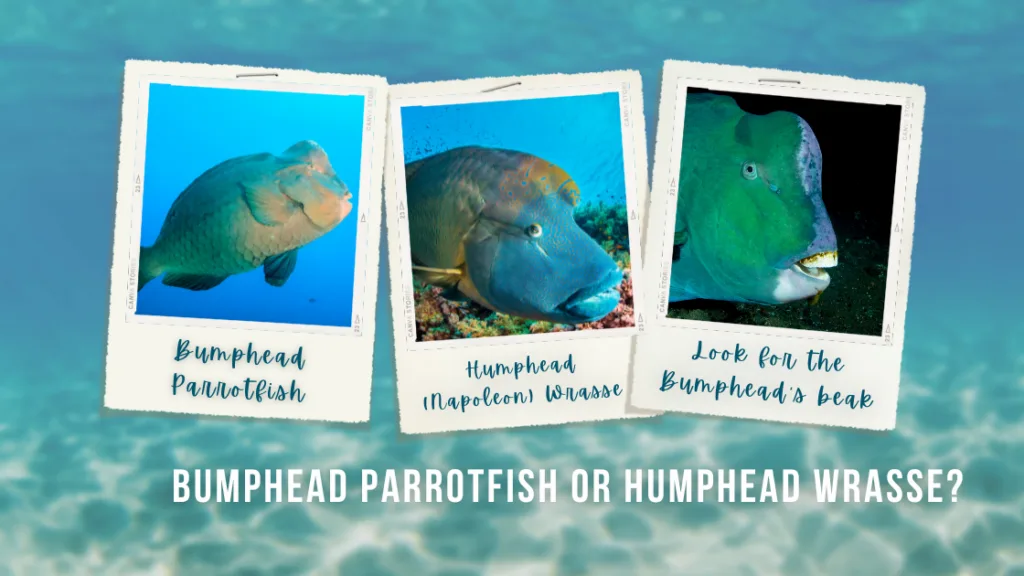
From this angle, they can easily be confused with the similarly sized and coloured (and even named) humphead wrasse. The easiest way to tell these species apart is by looking at the mouth – bumphead parrotfish have the typical parrotfish beak, whereas humphead (or Napoleon) wrasse have large, rounded lips.
Where to dive with them: Micronesia, Maldives, Philippines
Blue parrotfish (Scarus coeruleus)
The blue parrotfish is nice and easy to identify – as the name suggests, the adults are entirely blue. Young (also known as juvenile) parrotfish are mainly pale blue. Females can be a mixture of blue shades, and the males often have grey markings.
What’s more, juvenile blue parrotfish have a distinctive yellow spot on their head that slowly fades as they grow older.
Although they typically weigh around 20 lbs, the size of blue parrotfish varies considerably – they can be as short as 12 inches or as long as 47 inches!
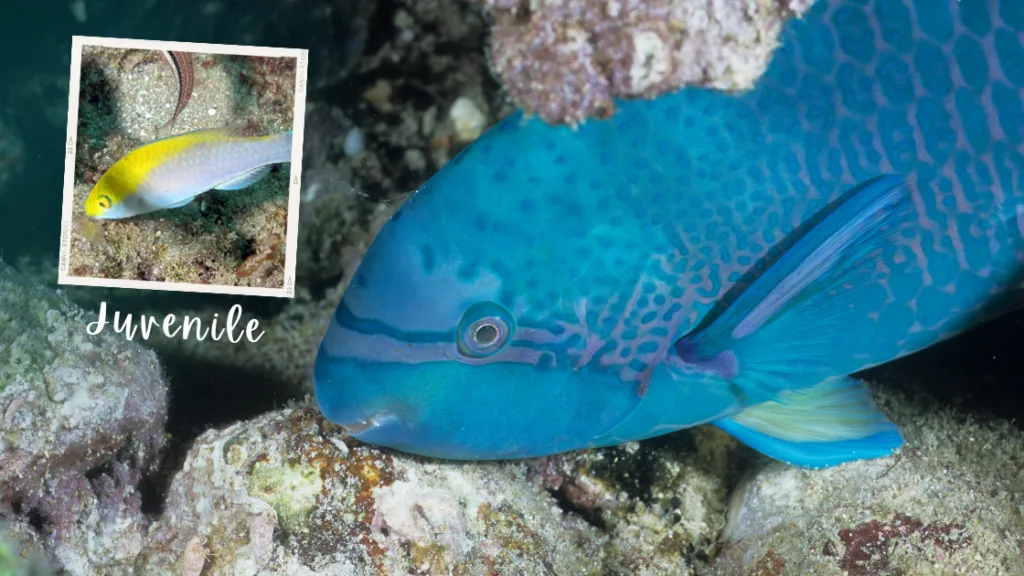
Blue parrotfish are also one of several parrotfish species that like to cocoon themselves in a protective layer of mucus at night. It’s thought that these bubbles protect the fish from predators, possibly by masking their scent, as well as protection from pesky parasites.
So, if you’re into night dives, make sure you take a closer look at that mucus bubble next time – maybe you’ll spot a parrotfish in there!
Where to dive with them: Brazil, Jamaica
Rainbow parrotfish (Scarus guacamaia)
Despite their name, rainbow parrotfish aren’t as colourful as you’d expect – the front part of the body is brown-orange and the rear is green. Rainbow parrotfish fins are brown/bronze, sometimes with dark blue hints. Confusingly, males and females tend to look very similar, although the males tend to be larger.
In fact, male rainbow parrotfish can grow to be an impressive 48 inches long and weigh a hefty 45lbs, making them one of the largest parrotfish species.
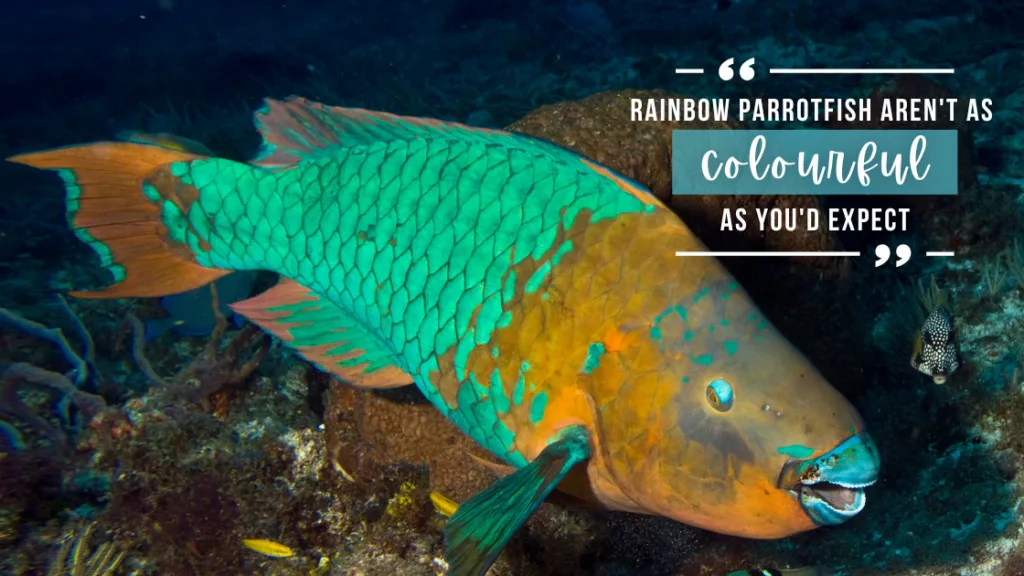
They’re typically found in subtropical water at depths of 3–25 metres, with juveniles preferring mangroves and adults preferring reefs. Like many other parrotfish, they’re known to retreat to the shelter of a local cave at night and when they feel threatened.
Unfortunately, global populations of rainbow parrotfish are declining, and the International Union for Conservation of Nature (IUCN) has listed this species as near threatened.
Where to dive with them: Bahamas, Bermuda
Stoplight parrotfish (Sparisoma viride)
The stoplight parrotfish is one of many parrotfish species that can change sex from female to male (often known as hermaphrodites). As they do this, their colour usually changes too.
In the female phase (also known as the initial phase), stoplight parrotfish have red-brown scales, red bellies, and scattered white dots running down their sides. Juveniles look similar to this, but their dots are more uniform.
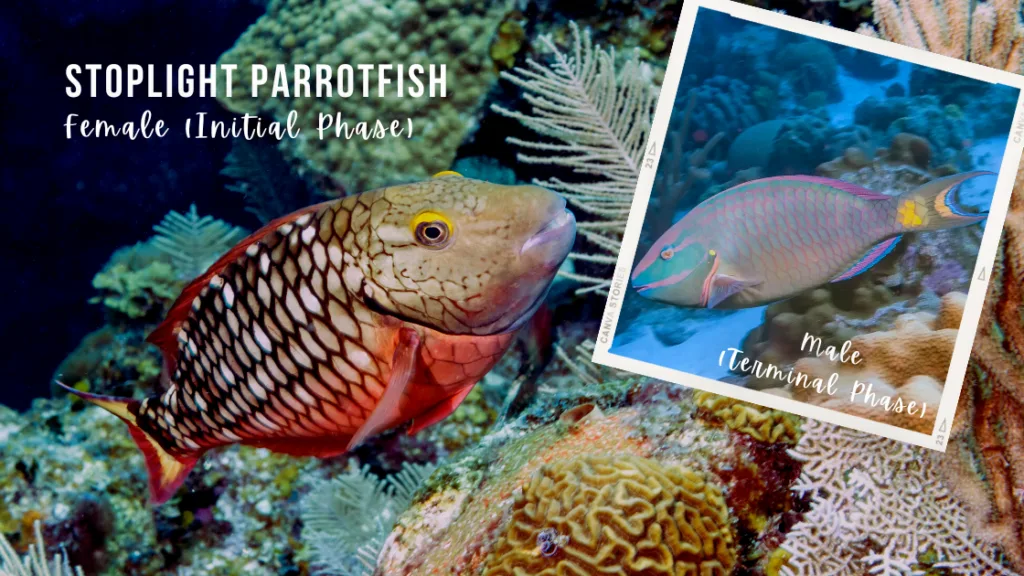
Once converted to males (known as the terminal phase) stoplight parrotfish look completely different – they’re green with bright orange-pink bands running along the head, a yellow dot behind the gill, and a yellow tail.
Interestingly, some males prefer to keep their female colours and become what is known as a female-mimic male.
Where to dive with them: Bermuda, Brazil
Princess parrotfish (Scarus taeniopterus)
Princess parrotfish are highly social beings. They like to head out in large groups to feed, but they do it during antisocial hours. Princess parrotfish are a diurnal species, which means that they like to feed at night and relax during the day.
So, if you spot a gang of parrotfish on the prowl for food on your next night dive, it might well be a school of princess parrotfish!
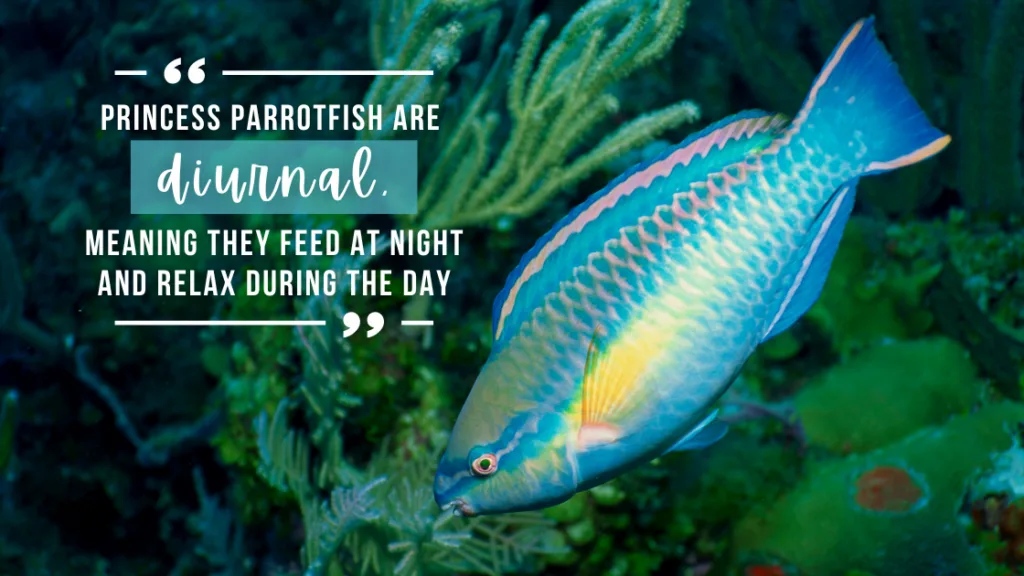
Males are blue with a band of yellow along the body, while females are pale with hints of orange-yellow around the edges and yellow fins.
Where to dive with them: Florida, Bahamas
Midnight parrotfish (Scarus coelestinus)
Midnight parrotfish are a mixture of black and – you might have guessed it – midnight blue. Unusually for parrotfish, juveniles, males and females are all similar in appearance, so they’re much easier to identify than some of the other species.
Midnight parrotfish can grow to be up to 30 inches in length and aren’t usually heavier than 15 lbs. They’re active during the day and like to sleep at night, and you can often spot them feeding in schools alongside surgeonfish.
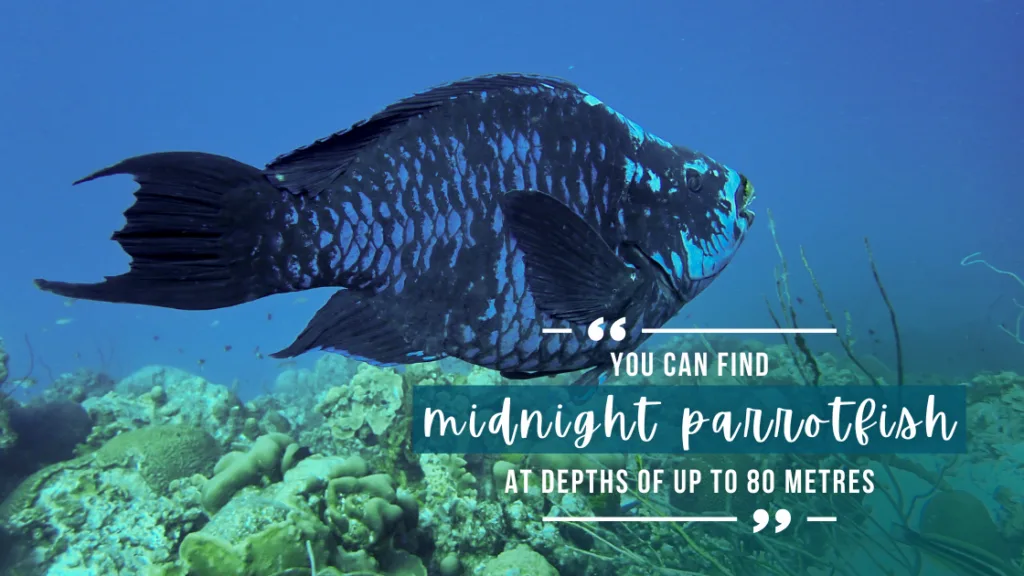
Although you can often spot them on the reef in water as shallow as 3 metres, midnight parrotfish like to dive deep sometimes – you can find them at depths of up to 80 metres.
Where to dive with them: Bahamas, Florida
Parrotfish are crucial for our reefs and islands
Technically, parrotfish are classified as ‘grazers’, which means that they feed on surfaces covered with algae. This can include rocks and coral.
Although fish eating coral might sound like bad news for coral reefs, it’s actually essential for reef development.
By removing algae, parrotfish make room for new coral colonies to grow as corals like to attach to hard surfaces. They also stop algae from smothering existing corals. Remember, corals need sunlight to grow – and they can’t get this if they’re covered with algae!
What’s more, parrotfish poop is crucial for the maintenance of tropical islands, where rising sea levels threaten to wipe them off the map. To put this into context, it’s thought that parrotfish poop makes up 85% of all sand produced on reefs in the Maldives!
Although most parrotfish populations are relatively stable for now, like most marine life, they’re under threat from rising ocean temperatures, pollution and fishing. Some species are even facing regional extinction.
Here are just a few things you can do to help the plight of marine animals like parrotfish:
- Eat less fish. Even if you aren’t eating parrotfish, a demand for fish means fishing will continue, which means overfishing, by-catch and plastic debris.
- Reduce your carbon footprint. Carbon-related temperature increases pose a serious threat to parrotfish.
- Cut down on plastics. Plastics big and small can pose a threat to marine life, so reduce, reuse and recycle whenever you can!

About the Author
Rose has spent the last few years living in Europe, the Seychelles and Kenya, working as a dive instructor, writer and conservationist. She’s back in the UK at the moment and is slowly acclimatising to cooler waters!

